Jon Reed's Blog, page 13
June 27, 2014
10 Ways to Win with WordPress
This article first appeared in issue 1 of Publishing Talk Magazine.
Want to start a book blog? Get up and running in minutes with WordPress.
 WordPress is the blogging software I always recommend. It is flexible, extendible, easy to use – and free. But there is more to it than writing a personal online journal. You can use it to build a website, promote your books – and build a community. Here are 10 ways to make the most of it:
WordPress is the blogging software I always recommend. It is flexible, extendible, easy to use – and free. But there is more to it than writing a personal online journal. You can use it to build a website, promote your books – and build a community. Here are 10 ways to make the most of it:
Create a website. Don’t want to start blogging yet? You still need a website, even if it is a simple one-page site with your contact details. WordPress is the easiest way to start a website with no technical knowledge.
Start blogging in minutes. Use http://wordpress.com to get your blog up and running in half an hour. This is hosted on the WordPress servers – so you don’t even need your own domain name or server space. If you do have these, you can use http://wordpress.org to download the software and upload it yourself.
Choose a great design. WordPress comes with many built-in ‘themes’ or designs that you can choose. If you want more control over the look and feel, use http://wordpress.org to customize the code or install a ‘premium’ WordPress theme.
Use widgets and plugins. Extend the functionality of your blog with free widgets and plugins. Widgets are for everyone and come built in. They add functions to the sidebar of your blog, such as your latest tweets. Plugins are only available to WordPress.org users, and add more complex functions such as contact forms.
Add contributors. You don’t have to do it all yourself. WordPress is set up for multi-author blogging, and you can add people with different permissions levels.
Write regularly. You don’t have to write a new blog post every day. Aim for once a week if you can – but more regularly than that when your blog is new and you are trying to build awareness and traffic. Ideally, write some posts in advance and schedule them to publish in the future.
Let people have their say. Social media is social – involve your readers, and let them comment on your blog posts. However, you should moderate comments to weed out spam, abuse and anything off-topic. People disagreeing with you is fine, and adds to the debate; blatant abuse is not.
Build a platform. I always advise creative writing students not to wait until they have a book to promote – start blogging now! This is how I, and lots of other authors, first got a book deal. Today agents and publishers want to see that you already have an audience.
Promote your blog. Once you have a blog, don’t rely on people finding you via search engines alone. Use Twitter and Facebook to get the word out to your online community. Use Twitterfeed to share your latest blog posts automatically to social networks as you publish them.
Build a community. Blogs are great for building community, especially if you build up a following on Twitter and Facebook. If you want to take things a step further and turn your blog into a social network, use BuddyPress.
Use your blog to flex your writing muscles, connect with new friends and post about your passions. Above all, enjoy it – blogging should be fun!
Download the current issue of Publishing Talk Magazine for free.
Find out more about blogging in Chapter 6 of Jon Reed’s book Get Up to Speed with Online Marketing.

May 16, 2014
Don’t Panic! 6 science fiction themes that illustrate a positive future for publishing
This article first appeared in issue 5 of Publishing Talk Magazine.
While some publishers view digital as a dystopian nightmare, Alastair Horne considers six science fiction themes and how they illustrate a more positive future for the industry.

Something not-quite-so wicked this way comes
Dystopian fiction has provided the publishing industry with some of its biggest recent successes – Suzanne Collins’s Hunger Games trilogy is reported to have sold more than 50 million copies in the past five years. The vision of a dystopian future that has had the greatest influence over publishing in recent times came not from a novel created for young adult readers, however; it is in fact the fate suffered by the music industry in its attempts to deal with to digital disruption.
Desperation to avoid this future has guided many of the publishing industry’s steps on its path towards a digital future. Fear of the piracy that ravaged the industry – from Napster to Bittorrent – has, for instance, led to an insistence on copy-protection which has in turn served to lock customers into a relationship with what some perceive as an even bigger threat: Amazon.
And yet, all the while, there has been a more optimistic future on offer, and from an area where one might expect to find such futuristic visions – the world of science fiction publishing. In this article, I’m going to consider six ways in which science-fiction publishing might represent a more positive future for the entire publishing industry.
1. Funders’ game
Increasingly widespread in recent years, the crowd-funding model sees artists finance projects by seeking investment directly from their audience, ahead of publication. The approach has proved particularly popular with musicians either unwilling or unable to find backing from record labels.
Kickstarter remains the best-known crowd-funding vehicle generally, but perhaps the most prominent variant on the model within the publishing industry comes from Unbound, which outsources the financing of the books it publishes to readers, whilst still providing many of the other activities conventionally associated with publishers, such as editing and marketing.
A recent move in the world of science fiction publishing, however, suggests a slightly different model, in which publishers do not entirely abdicate the investor role that has traditionally been such a key part of their contribution to the publishing process.
Earlier this year, Gollancz invested in a Kickstarter project set up to fund development of a sequel to the classic 80s computer game Elite, offering £13,500 in return for the rights to publish a series of three tie-in novels. The move suggests a future in which publishers might co-fund projects across different forms of media, in collaboration with other interested parties – readers, other media companies, the artists themselves – enabling them to share the costs of publication, and thus take greater risks.
2. Starship Two-fers
In September 2013 Amazon announced its new Matchbook offer, allowing readers to purchase digital copies of the print books they’d previously bought from the store, at a cost of up to £2.99 per title. Though at the time of the announcement, the offer was restricted to the United States, and only one or two of the big five publishers had signed up, it still attracted considerable attention both inside and outside the industry.
Of course, bundling physical and digital products together is hardly new; indeed it has been common across other media industries for some time: magazines and newspapers offer hybrid subscriptions through which a print edition is delivered through the subscriber’s letterbox and a digital edition to their smartphone or tablet, and some DVDs now come with codes by which the buyer can download a digital version. Indeed, Amazon’s own AutoRip, launched in 2013, offers buyers MP3 versions both of CDs they purchase in future, and of those they’ve previously bought from the retailer.
Publishing has been slow to join the party, perhaps in part because – as the launch of Matchbook has demonstrated – the player currently best placed to deliver ebooks bundled with print is Amazon. Few publishers are keen to strengthen their grip on the industry, as may be seen by the current absence of most of the big five publishers from Matchbook.
And yet the Osprey imprint Angry Robot successfully demonstrated how publishers might successfully work with smaller retailers on bundling so that both benefited financially. Offering ebook versions free with their print titles when bought in certain independent bookstores, Angry Robot saw sales treble during the first two weeks of the trial, while the bookstore found itself not only with a competitive advantage over the chains, but also relevant once again to ebook buyers. If the wider industry could attempt something similar in response to Matchbook, it might have the effect of increasing its earnings whilst also supporting a more diverse retail ecosystem.
3. The mid-list cuckoos
One of the more frequent complaints made by ebook buyers is the lack of catalogue on offer: only certain books by their favourite authors are available, with the works of many writers missing entirely.
The reasons behind such omissions are easily understandable. Most publishers have enormous backlists, built up over decades – if not centuries – and making these available in ebook formats is no quick or easy task. Often digital files for older titles don’t exist, necessitating the scanning and then checking of print originals. A further problem awaits once ebook versions have been made available: how to draw readers’ attention to titles that may have been out of print for years, without the benefits of even the minuscule marketing budget assigned to new titles?
One science fiction imprint offers a possible solution to this secondary problem. In the past two years, Gollancz has not only made more than 2000 of its backlist titles available as ebooks, but has also built a website, SF Gateway, to promote them. By incorporating content from the comprehensive Encyclopaedia of Science Fiction – which the publisher has made available in its entirety online for free – along with a forum, and a blog, Gollancz has turned an online catalogue into a go-to site for science fiction fans. Sales are up 50% year on year, and continued expansion is anticipated.
4. The DRMed world
The publishing industry’s continued use of copy-protection or digital rights management (DRM) technologies to ‘protect’ its books from unauthorised sharing is perhaps the clearest sign of how its actions are informed by its obsession with the dystopian vision of the future provided by the music industry.
Theoretically, DRM protects publishers from the tidal wave of piracy that swept away much of the music industry by preventing readers from sharing the books that they’ve bought with friends, or on file-sharing sites. In practice, however, these technologies have little or no effect on anyone capable of googling the term ‘DRM removal’ and then following basic instructions. Instead, they merely inconvenience readers who’d like to read all their books on a single device or in a single app – if you buy books from Amazon to read on your Kindle, you won’t be able to read them on another device, except via the Kindle app. With the majority of ebook buyers owning Kindles, the industry’s insistence on DRM thus ties readers to the very company that many within publishing see as a far greater threat to it than piracy, thanks to its increasing domination of both the print and ebook markets.
A few publishers are beginning to abandon the DRM consensus, however. The science fiction imprints Baen and Tor, among others, now both sell their ebooks directly to customers without DRM, making grand statements about the reader’s right to access the books they’ve bought however they choose. Neither has seen a significant increase in piracy since doing so. If other publishers were to follow suit, perhaps the industry might take a step towards a future less dependent upon a single retailer.
5. Slash – ah, ah – is going to save every one of us
Fan fiction has moved suddenly into the mainstream in the past eighteen months. First Fifty Shades of Grey slipped the chains of its origin as an erotic reworking of Twilight to become a massive international guilty pleasure. Then, earlier this year, Amazon launched Kindle Worlds, allowing fan fiction writers to publish – and sell – their own stories about other writers’ characters, provided that those original authors had signed up to the scheme.
In the decades before Fifty Shades and Kindle Worlds, though, what was the best-known example of fan fiction? Step forward – from the bridge of the USS Enterprise – Captain Kirk and Mr Spock, whose man-on-Vulcan love remained for many years the archetypal example of the ‘slash’ fiction in which fictional characters lose their inhibitions and their clothes. Once again, science fiction stands proudly ahead of the game.
6. Do androids stream?
Having survived – just – its opening encounters with digital, the music industry is busily creating a new dystopian vision of the future for itself: one in which its customers don’t buy content but instead pay a flat subscription fee to a third party (such as Spotify) to stream all the music they can manage. In this new model, according to the dystopian interpretation, content creators (those people we used to call ‘musicians’) are rewarded with royalty payments so tiny that none but the already massively successful can afford to make music.
The publishing industry already has its own equivalents of Spotify and Pandora. Outsiders ready to take advantage of the opportunities offered by digital distribution to shake up traditional business models include the likes of 24Symbols (for ebooks) and Bardowl (for audiobooks). Yet within the industry, there are also those attempting to explore subscription models, and in significantly different ways: Angry Robot offers its readers the opportunity to buy everything they publish over a six- or twelve-month period – a minimum of 12 or 24 ebooks – at a discount of a third on the cost of buying each book individually. By selling direct, and guaranteeing income up front, the publisher is able to offer such discounts without ending up out of pocket.
Genre publishers have an inbuilt advantage over the likes of HarperCollins and Penguin Random House, in that the products they sell are enough of a ‘known quantity’ for customers to feel able to risk buying them sight unseen. Yet it should not be beyond the ingenuity of larger publishing houses to create their own versions of this, offering subscriptions to individual imprints, or to authors. The benefits would be the same.
Good omens
At the heart of almost all these innovations lies one fundamental truth: that relationships with readers rest at the heart of any positive future for publishing. Understanding and responding to their needs, trusting them not to pirate content, and even involving them in the funding of books – publishers need to strengthen and deepen their relationship with readers if they’re to escape the dystopian future they fear. Science-fiction publishers offer them plenty of positive examples of how it can be done – can the rest of the industry respond?
With thanks to Darren Nash and Marcus Gipps of Gollancz for their help with the sections on crowd-funding and backlists, and to Lyn Strutt for improving the piece no end with her suggestions.
Follow Alastair Horne at pressfuturist.com or on Twitter at @pressfuturist.
Download this article as a free PDF- along with the rest of Publishing Talk Magazine issue 5.

December 11, 2013
The visual web: why images are an essential element of your social media
Have you noticed how visual a medium the web has become recently? In some ways this is a continuation of a long term trend. I remember when the internet was all text, with the occasional picture that took forever to download. Since then, it has steadily become more visual. The web then and now is like comparing an academic monograph to a highly illustrated coffee table book. Which would you rather read?
There are two reasons for this: improvements in technology, and diminishing attention spans. Super-fast wireless broadband means pictures download instantly, and video streams effortlessly for many people. Technological developments have made photo sharing and video sharing sites possible – and popular. The other reason is our shrinking attention spans which, online, are tiny. This is understandable – there is just so much online information to wade through these days, who has time to read lengthy paragraphs of text? We want succinct blog posts, short videos, and pictures. Something that will show us at a glance if we’ve found what we’re looking for. Something that will attract our attention and draw us in. Something that looks nice that we want to click on and share.
This is one reason why Pinterest is such a success. As an online scrapbook of images it is attractive – even addictive. As a social bookmarking site, it drives far more traffic to websites than previous text-based ones such as Delicious. There’s a reason why Facebook paid so much to acquire Instagram. But it is not just new, visual social networks springing up: the old ones are getting more visual too. Facebook’s timeline layout gives more weight to images. [UPDATE: Twitter has recently introduced timeline images too!] Facebook, Twitter and Google+ all have prominent header images on profiles now. This is becoming the norm for what social networks look like.
What does this mean for you?
Make sure you use plenty of images on your social networking sites
Make sure you use images on any web page or blog post that you want people to ‘pin’ to Pinterest – they can’t share your content if you don’t have a pinnable image!
This post is an extract from the Introduction to the 2nd edition of Get Up to Speed with Online Marketing. Read the full Introduction and Chapter 1 here.
[004]

December 9, 2013
The social web: why you need a social media presence

When did we all join the media business? How did the internet make this possible? When British computer scientist Tim Berners-Lee invented this thing called the World Wide Web in 1990, he could scarcely have imagined what it has become today: a ubiquitous part of our everyday lives. Fully integrated into our social lives, an essential business tool, and a creative multimedia platform. It has also progressively become a more media-rich visual medium, and it is now with us wherever we go thanks to that other technological trend of the age: mobile phones. These trends are interconnected, and now have a direct impact on the way we do business.
The Social Web
What is sometimes referred to as the ‘social web’ is now really just the web. We no longer say ‘motor car’ – we just say ‘car’. It is taken as read that our cars are motorized. So it is has become with the internet – it is a given that we use the Internet to connect with our friends, express our personalities and opinions, publish our photos or watch a video. It is the same with online marketing. Social media has just become the way we do that.
Social media is the currency of the social web. Most people might think of it as a collection of tools, websites and online services. For our purposes it is also helpful to think of it as an approach to marketing, and a subset of online marketing tools, which more broadly include websites, search engine marketing and email marketing. If you need convincing of just how much of the Web is social, you need only look up the top sites ranked by Alexa. The top three have for a long time been Google, Facebook and YouTube; with Wikipedia, Twitter, Blogger, LinkedIn, Pinterest and WordPress.com all occupying high positions.
Having a presence on social sites is a necessary but not sufficient prerequisite for successful social media marketing. Yes, you might have a gazillion followers – but are they buying anything? It’s easy to get carried away with the metrics and forget why you’re on social networks in the first place – to engage with your community. Get Up to Speed will help you with that.
What does this mean for you?
Ensure you have a presence on the main social websites, so that you are findable in the places your customers spend their online time.
If you want to build relationships with your customers, social media is now the way to do it online.
This post is an extract from the Introduction to the 2nd edition of Get Up to Speed with Online Marketing. Read the full Introduction and Chapter 1 here.
[003]

The social web

When did we all join the media business? How did the internet make this possible? When British computer scientist Tim Berners-Lee invented this thing called the World Wide Web in 1990, he could scarcely have imagined what it has become today: a ubiquitous part of our everyday lives. Fully integrated into our social lives, an essential business tool, and a creative multimedia platform. It has also progressively become a more media-rich visual medium, and it is now with us wherever we go thanks to that other technological trend of the age: mobile phones. These trends are interconnected, and now have a direct impact on the way we do business.
The Social Web
What is sometimes referred to as the ‘social web’ is now really just the web. We no longer say ‘motor car’ – we just say ‘car’. It is taken as read that our cars are motorized. So it is has become with the internet – it is a given that we use the Internet to connect with our friends, express our personalities and opinions, publish our photos or watch a video. It is the same with online marketing. Social media has just become the way we do that.
Social media is the currency of the social web. Most people might think of it as a collection of tools, websites and online services. For our purposes it is also helpful to think of it as an approach to marketing, and a subset of online marketing tools, which more broadly include websites, search engine marketing and email marketing. If you need convincing of just how much of the Web is social, you need only look up the top sites ranked by Alexa. The top three have for a long time been Google, Facebook and YouTube; with Wikipedia, Twitter, Blogger, LinkedIn, Pinterest and WordPress.com all occupying high positions.
Having a presence on social sites is a necessary but not sufficient prerequisite for successful social media marketing. Yes, you might have a gazillion followers – but are they buying anything? It’s easy to get carried away with the metrics and forget why you’re on social networks in the first place – to engage with your community. Get Up to Speed will help you with that.
What does this mean for you?
Ensure you have a presence on the main social websites, so that you are findable in the places your customers spend their online time.
If you want to build relationships with your customers, social media is now the way to do it online.
This post is an extract from the Introduction to the 2nd edition of Get Up to Speed with Online Marketing. Read the full Introduction and Chapter 1 here.
[003]

December 5, 2013
How to personalize your Google+ web address
One of the newer social media tools, and the subject of one of the new chapters in Get Up to Speed with Online Marketing, is Google+. I know. “Not another social media tool” was my initial reaction too; especially after so many false starts and abandoned forays into social networking by Google. But it pays to at least be aware of Google+ and the possibilities it can offer. And there have been a few recent interesting improvements that might encourage you to look again at Google:
The design has improved. Instead of a massive header image that takes up most of the screen, the look has been slimmed down, the header looks more stylish, and the posting area looks – well, Facebooky. In fact, you might consider using your Facebook header image, to reinforce your personal (or business) branding.
Automatic hashtags. Google+ now automatically adds keyword hashtags to any blog posts or articles you post to your profile, which saves you a job and helps other people find your content. You can edit these, or remove the automated option altogether if you want.
Personalized URLs. This was only a matter of time, and something long offered by other networks. A personalized or ‘vanity’ URL is useful not only for the search engine benefit, but so you have something a little snappier to put on email signatures or business cards than a long string of numbers. Here’s how to claim your personalized Google+ URL.
1. Do you qualify?

First of all, to qualify, you first need to meet some basic eligibility criteria:
Personal profiles – at least 10 followers, an account that is more than 30 days old, and a profile photo
Business pages – must be linked to a website or, for Local Google+ pages, be a verified local business.
Once you qualify, you should see a blue Get URL button at the top of your screen, in the middle of your header; or click Get URL under the Google+ URL listed at the top of your Links box on the About tab on your profile.
2. Decide what you want to change your Google+ URL to
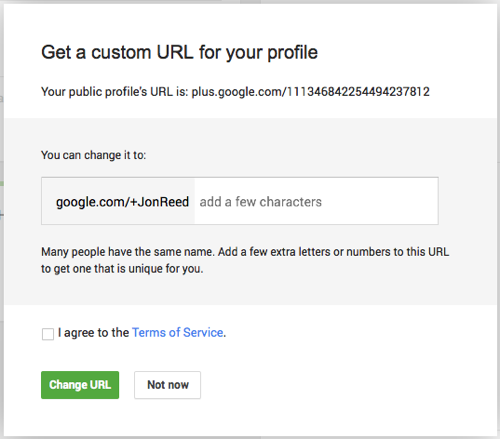
The first bit of your personalized URL – the bit after google.com/+ – will be your name (or the name of your page). If you’re lucky, this will be available. Otherwise you will need to add some more characters t make it unique.
3. Agree to the Terms of Service
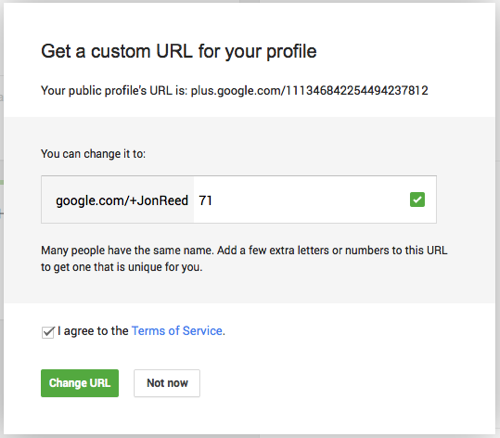
Once you have a URL that is available (indicated by the green tick), tick to agree to the Terms of Service and click the Change URL button.
4. Verify your mobile number
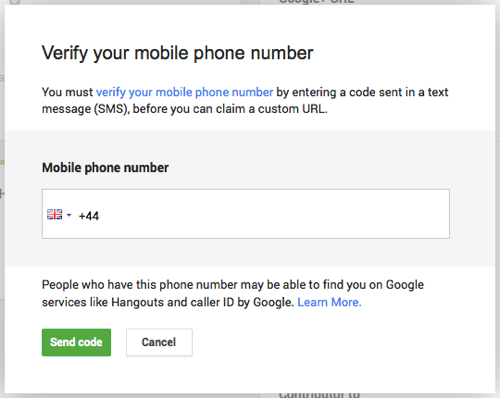
Google has an extra security feature built in to make sure it is really you who is changing your URL. Choose your country fronm the drop-down menu, enter your mobile phone number, and click Send code.
5. Enter the verification code
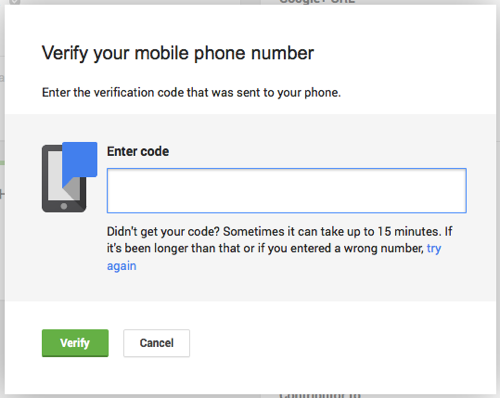
A code will be texted to you – enter this then click Verify.
6. Confirm your choice
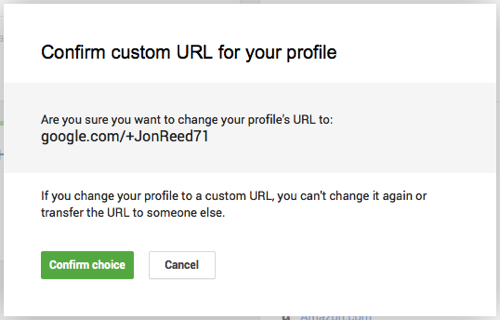
You will see a preview of your new Google+ URL. Are you absolutely sure you want to change it to this? You can’t change it later! If you’re sure, click Confirm choice.
7. Success!
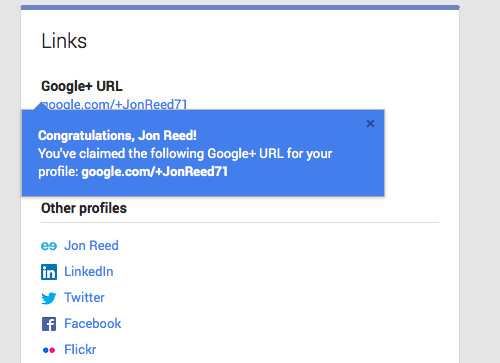
On the About tab of your profile you should see your new Google+ URL at the top of your Links box.
Google+ is another place for people to find you. It’s worth having a profile, even if you don’t plan to use it much, for the search engine benefit. If someone Google’s your name, one of the first things to come up will be your Google+ profile – especially if your name is part of the URL for your profile. And if you’ve filled in some links to other places people can find you online, they can connect with you there, even if you don’t use Google+. But, now that the interface has improved, you may be tempted to use it more.
Find out more about how to market yourself with Google+ in chapter 14 of the 2nd edition of Get Up to Speed with Online Marketing.

December 4, 2013
I’m a publisher. So are you.

My background is in publishing. I worked for various publishing companies for 10 years before starting my own business. In 2005 I studied part-time for a Postgraduate Diploma in Digital Media Management at Birkbeck, University of London – one of the courses I now teach on. This was the first time I came across social media – or ‘Web 2.0’ as everyone was calling it then. I started out building websites, creating digital media – and advising on social media. I narrowed my specialism to social media and continued to share what I had learned with others. Teaching is central to everything I do, whether it’s lecturing, running a workshop or in-house training, writing books or producing online learning materials.
Yet I’ve almost come full circle, because part of my business is now publishing magazines, ebooks and other learning resources at Publishing Talk – the online community of authors and publishers I have built up over the last few years. So, you might still call me a publisher. But here’s the thing: whatever your business is, if you are using social media you too are a publisher. My experience of publishing, social media and running a small business has made me realize just how interconnected these things are.
You don’t have to run a content business or a training business to benefit from social media. You don’t need to run a high-tech business or sell ‘information products’. You don’t even need to sell products from a website. You just need to have a presence online, use the social networks that your customers and prospects use, and give them a reason to connect with you. But you can’t just do a few tweets: you need to publish some content. That content is the starting point for your online marketing campaign, as you use it to reach and engage with potential customers and clients who will seek it out with their online searches.
The principles apply whether you are a carpenter or a bike shop. Anyone with an internet connection and a bit of creativity can now communicate with the world via the written word, audio, video and images. You don’t even need a computer – you can do it from your smartphone. A radical power shift of content creation and distribution from large media institutions to individuals has taken place over the past few years: everyone is a publisher now.
This post is an extract from the Introduction to the 2nd edition of Get Up to Speed with Online Marketing. Read the full Introduction and Chapter 1 here.
[002]

December 2, 2013
Social media is mainstream. Are you up to speed?

When Get Up to Speed with Online Marketing first published in 2010, you might have needed some persuading that social media marketing was something you needed to do. Today, you may need little convincing. There is no longer a battle between social media and mainstream marketing. Social media is the mainstream. Facebook has over a billion users, Twitter has over half a billion accounts, and people spend more time on social networks than they do on email.
Concentrate on being findable.
While “everyone else is doing it” isn’t a good enough reason in itself, if your competitors are on Twitter and Facebook and you’re not, you may be missing out. More importantly, it is likely that the very people you are trying to reach with your marketing messages are also on these sites. If your customers use social media, you need to use it too. The user numbers speak for themselves: these sites are neither faddy nor niche. A broad range of people use these sites, and some are your ideal clients, customers and prospects. Concentrate on being findable. If you can make your products or services easy to find online, you’re halfway there.
Social media is mainstream. If you’re not using it yet, you need to get up to speed – and quick. The good news is that you don’t need to do everything, and it’s easy to learn the basics. This website and accompanying book will show you which bits to focus on and why.
This post is an edited extract from the Introduction to the 2nd edition of Get Up to Speed with Online Marketing. Read the full Introduction and Chapter 1 here.
[001]

November 29, 2013
CASE STUDY: How a pair of property investors topped the iTunes charts by sharing their passion
 The Property Podcast is a weekly mix of property news and debate presented by Rob Bence who runs RMP Property and Rob Dix who runs Property Geek – both active property investors and podcast addicts who saw an opportunity to combine their passions.
The Property Podcast is a weekly mix of property news and debate presented by Rob Bence who runs RMP Property and Rob Dix who runs Property Geek – both active property investors and podcast addicts who saw an opportunity to combine their passions.
Soon after its launch in March 2013, the podcast was manually selected for promotion on the iTunes podcast homepage, appeared in the ‘New and Noteworthy’ list, and regularly beat the BBC’s own podcasts to rank #1 in the business category. By the end of its second month, it was achieving over 20,000 downloads per month.
The Robs deliberately selected a format that keeps episodes snappy and informal, while sharing valuable information in a medium that previously lacked any kind of property content. It balances entertainment and education, and incorporates plenty of listener interaction. They knew that reviews were important in determining their iTunes rankings, so they made a point of asking for reviews and reading them all out on the show – racking up 65 five-star reviews in their first three months.
The accompanying website, www.thepropertypodcast.com, includes transcripts (which help Google rankings), a call to join the show’s mailing list, and a way for listeners to leave questions as voicemail messages.
Get the idea: Think about something you’re passionate about which is currently poorly served – other people will be hungry for that information too. Decide on a format and a posting schedule, get some attractive artwork, and make the most of the first eight weeks when you’re eligible for the ‘New and Noteworthy’ chart. Above all, never try to sell anything to your audience: interact with them, ask for reviews, and drive them back to your website to get more useful information. The trust they’ll build up by spending half an hour a week in your company will generate sales leads without you even having to try.
This case study appears in chapter 7 of the new edition of Get Up to Speed with Online Marketing. Rob and Rob included the book as their ‘resource of the week’ in The Property Podcast, 07 Nov 13 (from 25.50). You can hear the episode on The Property Podcast website, by playing the embedded player below, or by subscribing on iTunes (well worth doing if you’re at all interested in property investment!)

October 29, 2013
10 Things to Consider for your Website Design Brief






